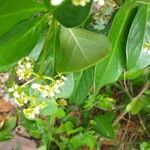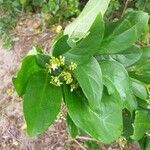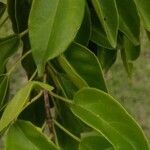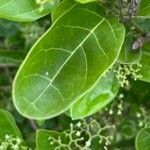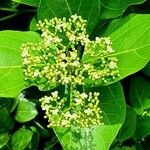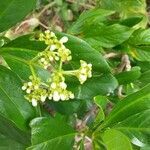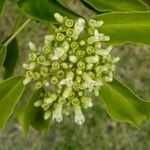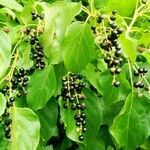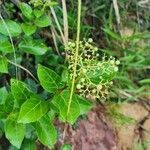Tree to 10 m high, often stunted; branchlets glabrous, often with hairs and glands at nodes. Leaves: lamina ovate to oblong, 3–14.5 cm long, 1.5–10 cm wide, rounded or truncate at base, entire margin, obtuse or acuminate at apex, glabrous, the undersurface glandular; petiole 1–3.5 cm long. Pedicels 0.5 mm long. Calyx 2-lipped with 1 lip 2-toothed, the other obscurely 3-toothed. Corolla colour unknown; tube 1–2 mm long, usually glabrous outside, somewhat constricted at insertion of stamens; lobes glabrous. Stamens just exceeding tube, shorter than lobes; filaments c. 0.5 mm long; anther locules not divergent at base. Ovary glabrous; style exceeding stamens and corolla lobes. Drupe 3–4 mm diam., glabrous. See also Cooper & Cooper (2004: 240), Zich et al. (2020).
Leaves opposite; blades 2.5–13.5(15) × 2–9 cm or more, broadly elliptic, elliptic-oblong or obovate-elliptic to suborbicular, rounded obtuse to subacute or shortly acuminate at the apex, cuneate or rounded to subcordate at the base, entire or crenate or subserrate to coarsely serrate above the middle, chartaceous to firmly membranaceous, dark green on both surfaces, glabrous or appressed pilose on the midrib and the main lateral nerves, or some hairs at the base of the midrib and in the lower nerve axils beneath; lateral nerves 3–5 per side, slender, ± prominent above, prominent beneath; petiole 0.5–3 cm long, usually slender, canaliculate, pubescent or puberulent, rarely hispid.
Corolla pale yellowish, whitish-green or greenish, 2-lipped; tube c. 3.5 mm long, cylindrical or ± funnel-shaped, pubescent outside and at the throat; limb upper lip 1.5 × 1.4 mm, entire or 2-lobed, lower lip 3-lobed, with the median lobe c. 1.5 × 2 mm and slightly concave, the lateral lobes a little smaller, glabrous or appressed puberulous outside.
A spreading shrub. It grows 2-4 m tall. It can be 12 m tall. The leaves are opposite and large. They are oval and shiny green. They are leathery and have prominent veins. The midrib is raised underneath the leaf. The flowers are in clusters near the ends of branches. They are greenish white. Fruit are small and green. They turn black at maturity.
Calyx 2.6 × 2.8 mm, campanulate, 2-lipped, with the upper lip entire or 2-lobed and the lower lip entire or shallowly 2–3-dentate, slightly puberulous and glandular on the outside.
Inflorescences terminal, corymbose, 3–8 × 4–10(14) cm or larger; peduncles 2–2.5 cm long, appressed-pilose; bracts 1–3 mm long, lanceolate or linear-lanceolate.
A much branched bushy shrub or tree up to 8 m tall, sometimes with sarmentose branches; indumentum of spreading simple or multicellular hairs.
Stamens didynamous, slightly exserted; filaments c. 1.8 mm long, filiform, wider and pilose at the base; anthers c. 0.6 mm long, ovoid.
Fruit black, c. 4 × 4 mm, subglobose, sitting in a shallowly cupuliform accrescent fruiting calyx 3–3.5 mm in diameter.
Branches striate, glabrescent; branchlets densely short-pubescent or appressed pilose; leaf-scars prominent.
Flowers unpleasantly aromatic.
Ovary incompletely 4-locular.
Style c. 4.8 mm long.
